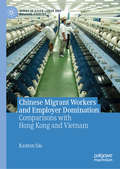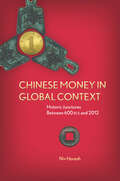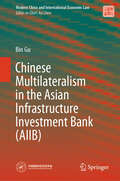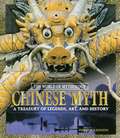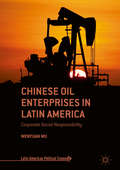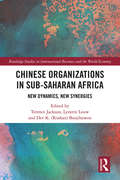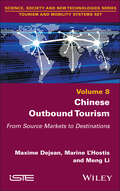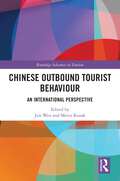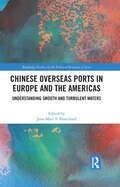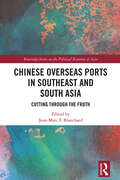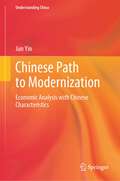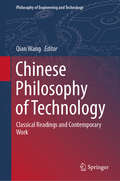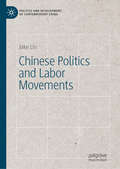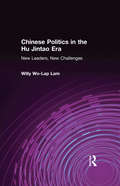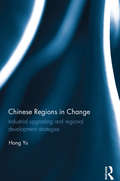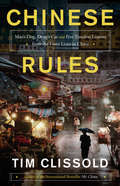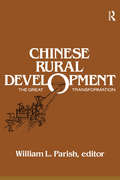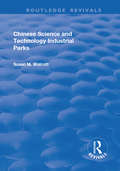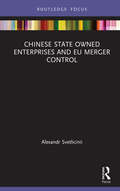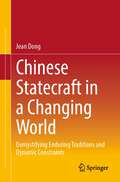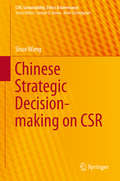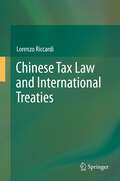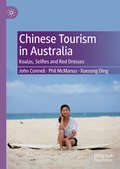- Table View
- List View
Chinese Migrant Workers and Employer Domination: Comparisons with Hong Kong and Vietnam (Series in Asian Labor and Welfare Policies)
by Kaxton SiuThis book explores three major changes in the circumstances of the migrant working class in south China over the past three decades, from historical and comparative perspectives. It examines the rise of a male migrant working population in the export industries, a shift in material and social lives of migrant workers, and the emergence of a new non-coercive factory regime in the industries. By conducting on-site fieldwork regarding Hong Kong-invested garment factories in south China, Hong Kong and Vietnam, alongside factory-gate surveys in China and Vietnam, this book examines how and why the circumstances of workers in these localities are dissimilar even when under the same type of factory ownership. In analyzing workers’ lives within and outside factories, and the expansion of global capitalism in East and Southeast Asia, the book contributes to research on production politics and everyday life practice, and an understanding of how global and local forces interact.
Chinese Money in Global Context: Historic Junctures Between 600 BCE and 2012
by Niv HoreshChinese Money in Global Context: Historic Junctures Between 600 BCE and 2012 offers a groundbreaking interpretation of the Chinese monetary system, charting its evolution by examining key moments in history and placing them in international perspective. Expertly navigating primary sources in multiple languages and across three millennia, Niv Horesh explores the trajectory of Chinese currency from the birth of coinage to the current global financial crisis. His narrative highlights the way that Chinese money developed in relation to the currencies of other countries, paying special attention to the origins of paper money; the relationship between the West's ascendancy and its mineral riches; the linkages between pre-modern finance and political economy; and looking ahead to the possible globalization of the RMB, the currency of the People's Republic of China. This analysis casts new light on the legacy of China's financial system both retrospectively and at present#151;when China's global influence looms large.
Chinese Multilateralism in the Asian Infrastructure Investment Bank (Modern China and International Economic Law)
by Bin GuThis book reflects the latest legal development of the Asian Infrastructure Investment Bank (AIIB), and makes direct and positive responses—it uses first-hand, authoritative information and makes insightful and persuasive analyses in addressing those concerns.In particular, this book provides nuanced analysis of the following topics:— capital allocation of the AIIB, in comparison with those of Bretton Woods institutions;— dynamic relationship between the shareholder board and management, a central topic of corporate governance for the AIIB and other MDBs;— AIIB’s environmental and social safeguards, including its frontier ESG portfolio investments, in comparison with the World Bank standards;— highly debatable issues relating to the interaction between AIIB, Belt and Road, and MCDF;— comparative study of state-owned enterprises in the laws of AIIB, WTO, ICSID, etc..This book targets academics, students, policymakers, and businesscircles who are interested in AIIB, given the bank’s growing importance in the context of global economic governance reforms. First, the book is a must for those who are keen to gain insight into the AIIB. Ten years have passed since the debut of the idea of AIIB in 2013, and the topic has never retreated from the debate of the international community—a major concern is whether a China-led multilateral development bank (MDB) remains to be politically neutral, or professional, and can live up to high standards.
Chinese Myth: A Treasury of Legends, Art, and History (Myth Ser.)
by Philip WilkinsonIn 1978, faced with the pressure to modernize and a declining budget, the Chinese People's Liberation Army (PLA) reluctantly agreed to join China's economic reform drive, expanding its internal economy to market-oriented civilian production. This work examines PLA's role in the economy up to 1998.
Chinese Oil Enterprises in Latin America: Corporate Social Responsibility (Latin American Political Economy)
by Wenyuan WuThis book focuses on corporate social responsibility (CSR) records of Chinese oil investments in five Latin American countries: Peru, Ecuador, Argentina, Colombia, and Venezuela. These investments have been spearheaded by China’s national oil companies and their behavior has been scantly studied. The author uses comparative case studies to empirically examine existing theories of CSR. By using oil companies as the basic unit of analysis, this project adds a micro-level dimension to the field of China-Latin America relationship. It is ideal for audiences interested in the political economy of the oil industry, China, Latin America, and corporate social responsibility.
Chinese Organizations in Sub-Saharan Africa: New Dynamics, New Synergies (Routledge Studies in International Business and the World Economy)
by Terence Jackson Lynette Louw Dev K. Rosh BoojihawonTrade between China and Africa is increasing year on year, while the Westincreasingly debates the nature and implications of China’s presence. Yetlittle research exists at the organizational and community levels. Whilewestern press reporting is overwhelmingly negative, African governmentsmostly welcome the Chinese presence. But what happens at themanagement level? How are Chinese organizations run? What are theybringing to communities? What is their impact on the local job market?How do they manage staff? How are they working with local firms? This book seeks to provide a theoretical framework for understandingChinese organizations and management in Africa and to explore howtheir interventions are playing out at the organizational and communitylevels in sub-Saharan Africa. Based on rigorous empirical researchexploring emerging themes in specific African countries, this book developsimplications for management knowledge, education and trainingprovision, and policy formulation. Importantly it seeks to inform futurescholarship on China’s management impact in the world generally, onAfrica’s future development, and on international and cross-culturalmanagement scholarship. Primarily aimed at scholars of international management, with aninterest in China and/or in China in Africa, this important book will alsobe of great interest to those working in the area of development studies,international politics, and international relations.
Chinese Outbound Tourism: From Source Markets to Destinations (ISTE Invoiced)
by Maxime DejeanChina's international tourism industry is gradually rising from the ashes after three years of travel restrictions imposed in response to China's "zero Covid" policy. This gradual recovery has prompted three geographers, specialized in understanding these trends, to pool their research and present an overview of the current state of Chinese international outbound tourism. Drawing on their extensive field experience in Wuhan, Phuket, Paris and Nice, these three researchers have combined their complementary and original approaches to explore the underlying mechanisms of the flow of Chinese tourists, from their origins to the most popular destinations. Chinese Outbound Tourism highlights the particularities of the Chinese tourism system, as well as the complex dynamics at work behind the 170 million international trips made before the pandemic by nationals of this "socialist country with Chinese characteristics".
Chinese Outbound Tourist Behaviour: An International Perspective (Routledge Advances in Tourism)
by Jun WenAssuming an international perspective, Chinese Tourist Outbound Behaviour presents an insightful exploration of the evolution of China’s tourism market, explores Chinese tourists’ behaviour, and considers how the country’s tourism landscape will expand in the future. Featuring 16 chapters compiled and written by industry experts representing 11 countries, this collection offers a vivid profile of Chinese tourists and the characteristics distinguishing them from other market segments. This book coincides with the growing interest in Chinese tourism and tourist behaviour as the top market in the world in terms of tourism spending and arrival numbers, presenting an overview of Chinese tourist segments and travel-related concerns to paint a clear picture of the market’s status. Chapters address the future of Chinese tourism, providing industry stakeholders an up-to-date view on this valuable market along with suggestions to best harness the market’s power. Providing an up-to-date exploration of numerous contemporary issues, this book will be valuable to a wide audience, including advanced students in tourism, hospitality and leisure and recreation studies and stakeholders, authorities, establishments and employees within the tourism industry. This book offers readers greater knowledge about the past, present and future of the Chinese outbound tourism market.
Chinese Overseas Ports in Europe and the Americas: Understanding Smooth and Turbulent Waters (Routledge Studies on the Political Economy of Asia)
by Jean-Marc F. BlanchardThis book analyzes the progress, gains, and effects of Chinese overseas ports through in-depth and systematic studies of numerous cases in Europe and Latin America. China’s participation in overseas ports, especially under the rubric of the Belt and Road Initiative, is a matter of great concern to businesspeople, policymakers, and researchers pondering the implications of Chinese infrastructure activities and overseas investment. Yet there is insufficient knowledge concerning the actual nature of China’s role in specific ports, the economic and other consequences associated with that involvement, and the wider economic, political, and environmental effects of those economic effects. The chapters of this book fill these gaps by examining ports in diverse European countries like Denmark, Germany, Greece, the Netherlands, and the United Kingdom and various Latin American countries, including Brazil and Jamaica. The book illustrates why Chinese seaports succeed or fail, why they have the military, economic, and other consequences that they do, and why these consequences produce or fail to generate other effects such as political influence. This book will appeal to audiences with interests in China’s overseas seaports, foreign direct investment (FDI), and infrastructure specifically and foreign direct investment, geopolitics, and the political economy of national security more generally.
Chinese Overseas Ports in Southeast and South Asia: Cutting Through the Froth (Routledge Studies on the Politcal Economy of Asia)
by Jean-Marc F. BlanchardThis book examines PRC “involved” seaports overseas, where involvement can take the form of PRC foreign direct investment (FDI), contracting, and/or terminal operations, in countries such as Cambodia, Pakistan, and the Philippines.Including country-oriented chapters the book sheds light on inter alia the realization (or not) of Chinese seaports, the effects of Chinese participation on port performance, trade, FDI, employment, and the environment, and the wider economic, political, and other ramifications of China’s role. Importantly, the case studies in the book clearly demonstrate that amongst these ports there are successes and failures, positive or negative effects are not preordained, and domestic and international political factors notably influence what occurs in these overseas ports. The book also illuminates the critical role of 3rd parties (including India) in shaping the dynamics of China’s participation in Southeast and South Asian ports and evaluate the potential for Chinese-involved ports to become naval bases.Presenting contributions from experts on Southeast and South Asia and utilising rich empirical data to reveal the factors that are driving China's participation overseas this book will appeal to students and scholars of Asian and Southeast Asian studies, international relations, particularly through the lens of economic relations.
Chinese Path to Modernization: Economic Analysis with Chinese Characteristics (Understanding China)
by Jun YinThis book exploratively reviews and refines the theoretical system of economics with Chinese characteristics and the analytical framework of Chinese path to modernization. This book aims to reveal answers to the three questions: what has the theoretical system of economics with Chinese characteristics inherited and developed? What are the experiences and lessons of all countries’ modernization in the world? What is the universality and particularity of Chinese Path to Modernization? As conclusion, the author draws a clue to understand Chinese path to modernization, which is neither “making up for the lessons” nor a “convergence”, but an “innovation” built upon the general principles of modernization. Its universality lies in the overall patterns and trends of modernization, that is, the consistent process of the country's pursuit of national economic growth and people's prosperity. The distinctiveness of this path lies in the concurrent transformation of Chinese economic system and the institutional innovations with Chinese characteristics that unfold throughout this ongoing economic process.
Chinese Philosophy of Technology: Classical Readings and Contemporary Work (Philosophy of Engineering and Technology #34)
by Qian WangThis book gathers essays that introduce the ideological advances in the philosophy of engineering and technology in contemporary China. It particularly focuses on China’s distinctive concepts and methods, revealing different views and academic debates to offer readers a comprehensive overview of this important field.The contributors present unique perspectives based on practical problems and traditional philosophy, examining such issues and concepts as axiology and theories of process, the difference between engineering activities and technology activities, and the core of the relationship between “Dao” and “Technique.”Other essays cover the ethics of technology, practical wisdom (phronesis) and practical reasoning, as well as creative concepts and methods concerning the philosophical problems in high technology, architectural technology, and technological innovation. The authors also consider more general issues in the field.This book compiles the relevant research achievements of Chinese scholars in various time periods. Some authors have revised and translated into English papers published in Chinese, while others present their research in English specifically for this study. An annotated bibliography of the major publications in the field completes this collection.
Chinese Politics and Labor Movements (Politics and Development of Contemporary China)
by Jake LinThis book brings a radically new voice to the debate in the field of Chinese politics and labor movement. Using a psychological and cognitive approach, the author examines workers and activists’ everyday interpretation of the source of their problems, their prospect of labor movements, and their sense of solidarity. The project shows how workers themselves have become a part of the apparatus of state repression and argues that Chinese workers have not acquired sufficient cognitive strength to become the much hoped-for agent for political change, which hinders labor activism from developing into a sustainable social movement. Multidisciplinary in its approach, the monograph provides analysis of Chinese politics, labor studies, international political economy, social movements, and contentious politics.
Chinese Politics in the Hu Jintao Era: New Leaders, New Challenges
by Willy LamDrawing on hundreds of interviews with top Chinese officials, parliamentarians, scholars, and businessmen, Willy Lam, a renowned journalist and writer on Chinese affairs, presents a first-hand, multi-dimensional account of twenty-first century China and the impact of fourth generation leaders, including President Hu Jinato and Premier Wen Jiabao. Lam goes behind the glitzy facade of nouveau-riche Beijing and Shanghai to examine how the Hu leadership has tried to extend the Communist Party's "mandate of heaven" by tackling an array of daunting problems: the weakening legitimacy of the Party's leadership; restive peasants; angry workers; political stagnation over the lack of reform; foreign relations difficulties; unreliable energy supplies; resurgent nationalism; and the increasingly dubious "Chinese model" of development. The author assesses possible contributions that the new classes of private businessmen, professionals, and intellectuals - as well as new ideas such as nationalism, globalization, and federalism - will make to economic prosperity and political liberalization. The book also includes a chapter on foreign policy, which contains an insightful account of Beijing's evolving and sometimes difficult relations with the United States, Europe, Japan, and other major countries and blocs, as well as the role of the People's Liberation Army.
Chinese Regions in Change: Industrial upgrading and regional development strategies
by Hong YuThis book offers extensive and quality research on and original insights into China’s internal regional dynamics. It provides a focused analysis of the internal dynamics and regional economic diversity of China covering the eastern, central and western regions through case study, data analysis and review of state-initiated policy measures. The book also identifies and analyses existing and potential challenges facing China’s regions in their pursuit of sustainable development. Different regions in China have attempted to achieve fast economic growth and move up the industrial value chain through industrial restructuring and upgrading, inter-regional industrial transfer, urbanization or seeking central government’s endorsement of new regional policies. The book examines the difference and similarities among local government policies to boost regional industrial and economic growth and assesses their implications and effectiveness. The author had conducted detailed studies in this field in order to bridge the existing research gap and the book will help to give rise to useful and illuminating discussion.
Chinese Restriction, Violence, and Exclusion in the United States
by Tom Nicholas Boyang Han Tomas RosalesCase
Chinese Rules: Mao's Dog, Deng's Cat, and Five Timeless Lessons from the Front Lines in China
by Tim ClissoldFrom the author of the acclaimed Mr. China comes another rollicking adventure story—part memoir, part history, part business imbroglio—that offers valuable lessons to help Westerners win in China.In the twenty-first century, the world has tilted eastwards in its orbit; China grows confident while the West seems mired in doubt. Having lived and worked in China for more than two decades, Tim Clissold explains the secrets that Westerners can use to navigate through its cultural and political maze. Picking up where he left off in the international bestseller Mr. China, Chinese Rules chronicles his most recent exploits, with assorted Chinese bureaucrats, factory owners, and local characters building a climate change business in China. Of course, all does not go as planned as he finds himself caught between the world’s largest carbon emitter and the world’s richest man. Clissold offers entertaining and enlightening anecdotes of the absurdities, gaffes, and mysteries he encountered along the way.Sprinkled amid surreal scenes of cultural confusion and near misses, are smart myth-busting insights and practical lessons Westerns can use to succeed in China. Exploring key episodes in that nation’s long political, military, and cultural history, Clissold outlines five Chinese Rules, which anyone can deploy in on-the-ground situations with modern Chinese counterparts. These Chinese rules will enable foreigners not only to cooperate with China but also to compete with it on its own terms.
Chinese Rural Development: The Great Transformation
by William L. ParishThis text examines the Pacific War, the Korean War and the Vietnam War, from the perspective of those who fought the wars and lived through them. The relationship between history and memory informs the book, and each war is relocated in the historical and cultural experiences of Asian countries.
Chinese Science and Technology Industrial Parks: Developing The Dragon's Head (Routledge Revivals Ser.)
by Susan M. WalcottTitle first published in 2003. This book examines types of advanced technology Chinese districts set aside for developing products for national and global markets. Culminating in a proposed best practice model for Chinese integration into global networks, based on China's own particular political economy.
Chinese State Owned Enterprises and EU Merger Control
by Alexandr SvetliciniiThis book analyzes the specifics of corporate governance of China’s State Owned Enterprises (SOEs) and their assessment under EU merger control, which is reflected in the EU Commission’s screening of the notified economic concentrations. Guided by the going global policy and the Belt and Road Initiative, Chinese SOEs have expanded their global presence considerably. Driven by the need to acquire cutting edge technologies and other industrial policy considerations, Chinese SOEs have engaged in a series of corporate acquisitions in Europe. The main objective of this book is to demonstrate the conceptual and regulatory challenges of applying traditional merger assessment tools in cases involving Chinese SOEs due to the specifics in their corporate governance and the regulatory framework under which they operate in China. The book also explores the connection between the challenges experienced by the merger control regimes in the EU and the recent introduction of the EU foreign direct investment screening framework followed by a proposal concerning foreign subsidies. The book will be a useful guide for academics and researchers in the fields of law, international relations, political science, and political economy; legal practitioners dealing with cross-border mergers and acquisitions; national competition authorities and other public bodies carrying out merger control; policy makers, government officials, and diplomats in China and the EU engaged in bilateral economic relations.
Chinese Statecraft in a Changing World: Demystifying Enduring Traditions and Dynamic Constraints
by Jean DongThis book addresses one of the most pressing geopolitical inquiries of our era: how will China's ambition manifest on the global stage? To address this question, the book considers China’s long tradition of statecraft. By doing this, it provides a unique and novel insight into the “why” behind China’s actions and sparks a crucial dialogue on “how” to best navigate China’s global rise. Through a keen analytical lens, the book illuminates both the constraints and the flexibility inherent in Chinese policy-making. It underscores the geographic and historical factors that constrain China's actions, forcing its leaders into trade-offs. It also highlights the system's inherent flexibility, expanding the range of strategic options available when dealing with China. The most unique contribution consists in framing the pre-occupations of contemporary China in the context of both long-standing Chinese trends and unprecedented global changes. This book offers a nuanced and realistic guide for senior policy makers, business leaders, academic researchers, and global citizens who seek to decipher the enigma of China's ascent and channel its trajectory towards a more positive and responsible direction.
Chinese Strategic Decision-making on CSR (CSR, Sustainability, Ethics & Governance)
by Shuo WangThis research study attempts to provide a comprehensive CSR literature review, analyze corporate social responsibility (CSR) issues from the strategic decision-making (SDM) perspective, and investigate the process of managers' CSR- related SDM in China. In particular, it utilizes content analysis to examine selected CSR articles from published studies, in order to evaluate the trends in CSR theory development as well as to identify the variables, constructs, and relationships within CSR theory. The review indicates that CSR should be involved in organizational strategies. Therefore, this study reviews the relevant theoretical and empirical literature in the SDM area. Firstly, it summarizes the broader context of strategic decisions and points out factors in the external environment and organizational characteristics that influence the SDM process of managers. Secondly, it articulates the influences of individual characteristics on the SDM. Thirdly, it examines the process of SDM using the rational and bounded rationality theory of decision making. Finally, on the basis of the SDM model, the author generates a research model which proposes the links between vital and influential factors from an integrated perspective. This book also provides a detailed description of how to choose a proper method for the CSR-related SDM research, the process of survey design, sampling methods, and survey administration. In particular, the author utilized a policy-capturing method to develop a series of scenarios concerning CSR activities and an explanation of this method is provided. It reports research findings of this study and provides an extensive and thorough discussion and compares it with previous empirical studies. The conclusion summarizes the research findings and their theoretical and practical implications.
Chinese Strategic Thought toward Asia (Strategic Thought In Northeast Asia Ser.)
by Gilbert RozmanTracing the development of Chinese strategic thinking over four distinct periods from the 1980s on, this book covers China's strategies regarding Russia and Central Asia, Japan, the Korean peninsula, and Southeast and South Asia. While it pinpoints many mistaken assumptions, it credits China with overall successes and concludes that China stands at a crossroads. Deng Xiaoping's legacy - a tendency toward patiently biding time in international affairs - may be replaced by a growing assertiveness emboldened by China's rapid rise.
Chinese Tax Law and International Treaties
by Lorenzo RiccardiThe People's Republic of China's tax policies and international obligations are as multifaceted and dynamic as they are complex, developing closely with the nation's rise to the world's fastest-growing major economy. Today, after decades of reform and the entry into the World Trade Organization, China has developed regulatory systems that enable it to provide stable administration, including a tax structure. China's main tax reform can be attributed to the enactment of the Enterprise Income Tax Law, which came into effect on January 1, 2008. Chinese tax regulations include direct taxes, indirect taxes, other taxes, and custom duties and from a collection point of view, China's tax administration adopts a very devolved system, with revenue collected and shared between different levels of government in accordance with contracts between the different levels of the tax administration system. With respect to international treaties, China has established a network of bilateral tax treaties and regional free trade agreements. This publication describes in detail China's complex tax system and policies, as well as major bilateral treaties in which China has entered into using country-by-country analysis. Lorenzo Riccardi is Tax Advisor and Certified Public Accountant specialized in international taxation. He is based in Shanghai, where he focuses on business and tax law, assisting foreign investments in East Asia. He is an auditor and an advisor for several corporate groups and he is partner and Head of Tax of the consulting firm GWA, specializing in emerging markets.
Chinese Tourism in Australia: Koalas, Selfies and Red Dresses
by John Connell Phil McManus Xuesong DingThis book investigates all facets of Chinese tourism in a single destination, and its fascinating rise and evolution. It provides an overview of the first two decades of twenty-first century Chinese tourism in Australia, covering the early days, when Chinese tourism was mainly guided package tours with tourists visiting standard iconic sites, and its evolution into more individualistic tourism, with younger tourists seeking out sites of particular interest. Many of these ‘new sites’ are places where self-photography has particular merit, chosen in part because they are colourful, and images are distributed in real time to communicate with others and enhance social status. This quest for distinctiveness and colour has contributed to creating a distinctly Chinese tourist geography of Australia, analysed here in relation to conventional tourism geographies. The book takes a deliberately chronological approach to focus on the speed of change, discussing the more exciting and active ’new tourism’ in ways that integrate qualitative and quantitative research, and provide a basis for international comparison and discussion of key emerging themes in tourism studies.
